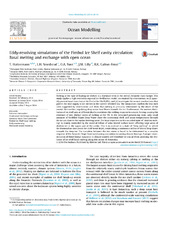| dc.contributor.author | Hattermann, Tore | eng |
| dc.contributor.author | Smedsrud, Lars Henrik | eng |
| dc.contributor.author | Nøst, Ole Anders | eng |
| dc.contributor.author | Lilly, Jonathan M. | eng |
| dc.contributor.author | Galton-Fenzi, Ben K. | eng |
| dc.date.accessioned | 2015-03-17T13:14:35Z | |
| dc.date.available | 2015-03-17T13:14:35Z | |
| dc.date.issued | 2014-10 | eng |
| dc.identifier.issn | 1463-5003 | en_US |
| dc.identifier.uri | https://hdl.handle.net/1956/9546 | |
| dc.description.abstract | Melting at the base of floating ice shelves is a dominant term in the overall Antarctic mass budget. This study applies a high-resolution regional ice shelf/ocean model, constrained by observations, to (i) quantify present basal mass loss at the Fimbul Ice Shelf (FIS); and (ii) investigate the oceanic mechanisms that govern the heat supply to ice shelves in the Eastern Weddell Sea. The simulations confirm the low melt rates suggested by observations and show that melting is primarily determined by the depth of the coastal thermocline, regulating deep ocean heat fluxes towards the ice. Furthermore, the uneven distribution of ice shelf area at different depths modulates the melting response to oceanic forcing, causing the existence of two distinct states of melting at the FIS. In the simulated present-day state, only small amounts of Modified Warm Deep Water enter the continental shelf, and ocean temperatures beneath the ice are close to the surface freezing point. The basal mass loss in this so-called state of “shallow melting” is mainly controlled by the seasonal inflow of solar-heated surface water affecting large areas of shallow ice in the upper part of the cavity. This is in contrast to a state of “deep melting”, in which the thermocline rises above the shelf break depth, establishing a continuous inflow of Warm Deep Water towards the deep ice. The transition between the two states is found to be determined by a complex response of the Antarctic Slope Front overturning circulation to varying climate forcings. A proper representation of these frontal dynamics in climate models will therefore be crucial when assessing the evolution of ice shelf basal melting along this sector of Antarctica. | en_US |
| dc.language.iso | eng | eng |
| dc.publisher | Elsevier | en_US |
| dc.rights | Attribution CC BY | eng |
| dc.rights.uri | http://creativecommons.org/licenses/by/3.0/ | eng |
| dc.subject | Ice/ocean interaction | eng |
| dc.subject | Continental shelf/slope exchange | eng |
| dc.subject | Antarctic Slope Front processes | eng |
| dc.subject | Fimbul Ice Shelf basal melting | eng |
| dc.subject | Eddy overturning | eng |
| dc.subject | Mesoscale ocean modeling | eng |
| dc.title | Eddy-resolving simulations of the Fimbul Ice Shelf cavity circulation: Basal melting and exchange with open ocean | en_US |
| dc.type | Peer reviewed | |
| dc.type | Journal article | |
| dc.date.updated | 2015-03-04T09:52:15Z | en_US |
| dc.description.version | publishedVersion | en_US |
| dc.rights.holder | Copyright 2014 The Authors | en_US |
| dc.identifier.doi | https://doi.org/10.1016/j.ocemod.2014.07.004 | |
| dc.identifier.cristin | 1175534 | |
| dc.source.journal | Ocean Modelling | |
| dc.source.40 | 82 | |
| dc.source.pagenumber | 28-44 | |
| dc.subject.nsi | VDP::Mathematics and natural scienses: 400::Geosciences: 450::Quaternary geology, glaciology: 465 | en_US |
| dc.subject.nsi | VDP::Mathematics and natural scienses: 400::Geosciences: 450::Oceanography: 452 | en_US |
| dc.subject.nsi | VDP::Matematikk og naturvitenskap: 400::Geofag: 450::Kvartærgeologi, glasiologi: 465 | nob |
| dc.subject.nsi | VDP::Matematikk og naturvitenskap: 400::Geofag: 450::Oseanografi: 452 | nob |

